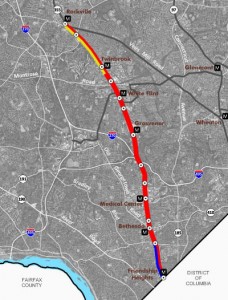Following two well-attended public hearings last week on the proposed Bus Rapid Transit system, the Montgomery County Council will now consider transit routes, approximate station locations, and rights-of-way. But one of the most significant policy issues will be whether the county gives transit priority on key routes with bus-only lanes.
Dedicated lanes allow for much faster, much more reliable service, which in turn attracts more riders and lowers costs per passenger. They make rapid transit a real alternative to driving in traffic, but removing general travel lanes to create bus-only lanes can be a hard sell to some members of the public. After all, many people consider it common sense that eliminating a lane of traffic will cause traffic to exponentially worsen.
Fortunately, evidence suggests that eliminating a lane often has no serious adverse effect on traffic. It may seem counter-intuitive, but removing a lane can occasionally cause traffic to flow better than it did before.
In 2002, a team of researchers looked at hundreds of situations where transportation planners reallocated roadspace away from general car travel. Most situations they examined experienced little to no increase in traffic, and in many cases local transportation planners reported, “the traffic has disappeared and we simply don’t know where it has gone to.”
The empirical evidence from dozens of case studies demonstrates that reducing roadspace for cars, especially when paired with providing better transit options for residents, can actually improve traffic operations. All of the case studies looked at affected and surrounding roads, and over half the cases saw more than a 10% reduction in traffic in the area.
Of the bus lanes studied in their report, there was an average 5% decrease in overall traffic. The study concludes that people make a much wider range of behavioral responses in these cases, including switching modes from driving to transit, chaining trips, or shifting their travel times away from peak hours.
Other recent traffic studies on repurposing lanes for transit have predicted a similar result. In Alexandria and Arlington, where the Potomac Yard-Crystal City BRT line will open in 2014, the traffic analysis for the environmental impact statement indicated that dedicating one curb lane in each direction to transit vehicles would cause no significant change in traffic flow.
In fact, modeling indicates that where repurposed curbside lanes are planned in Crystal City, exclusive lanes for buses help to channelize automobile flow and reduce traffic delays compared to not doing anything at all. In other parts of the corridor, the modeling predicted minor increases in traffic at a few intersections, balanced out by reductions in traffic at other intersections. Meanwhile, transit planners from Seattle tell us that their traffic study predicts a similar result on Aurora Avenue where plans call for repurposing two curb lanes for transit service.
In New York, data on traffic flow following the creation of bike lanes and bus lanes, as well as closing some streets to car traffic completely, indicates that traffic speeds have actually improved. The data matches similar observations in Brooklyn that travel times on Prospect Park West decreased after city planners converted a car lane to a bike lane several years ago.
The Maryland State Highway Administration is already planning on giving lane repurposing a try along the Purple Line on University Boulevard. SHA will reallocate two center lanes to the light rail line instead of widening an already large arterial road. The agency will make other improvements in the surrounding area to mitigate potential traffic impacts and keep people moving.
Planners and traffic engineers will be able to learn from that experience as they implement BRT in Montgomery County. The BRT plan recommends repurposed lanes where forecast transit ridership exceeds the capacity of a general traffic lane to move single occupant vehicles, a simple but sensible threshold.
While there are choke points along some of the corridors, in general, the proposed BRT routes are wide roads with six or more lanes. Montgomery planners and transportation officials alike seem to understand that continuing to widen these roads forever is not desirable, given the negative impact on neighborhoods and the long-term ineffectiveness of such an approach.
Lane repurposing offers the opportunity to move more people in Montgomery County’s limited road space. When combined with simultaneous improvements to bike and pedestrian networks that connect neighborhoods and work centers to the BRT stations, dedicated bus lanes offer Montgomery its best chance to create safer roadways that encourage walking, biking, and transit use.
Experience from other cities show that we can’t assume that traffic will increase. If we build a great system that can actually attract riders, traffic may not change much at all, and in fact may even decrease.
Photo courtesy of Oran Viriyincy. Click here to read the original story.


